Last Updated on June 20, 2024 by Michelle
Ever thought about trying to make your own maple syrup? This is the first in a multi-part series documenting my family’s failures (lots) and successes (a few) at our first attempt to do so. And I’ll fill you in on our results this year as well… it should be a SWEET series.
btw, before you hesitate that you have the right trees for tapping, check out this list I’ve put together, after many years of research, of 31 trees that can be used for sugarmaking.
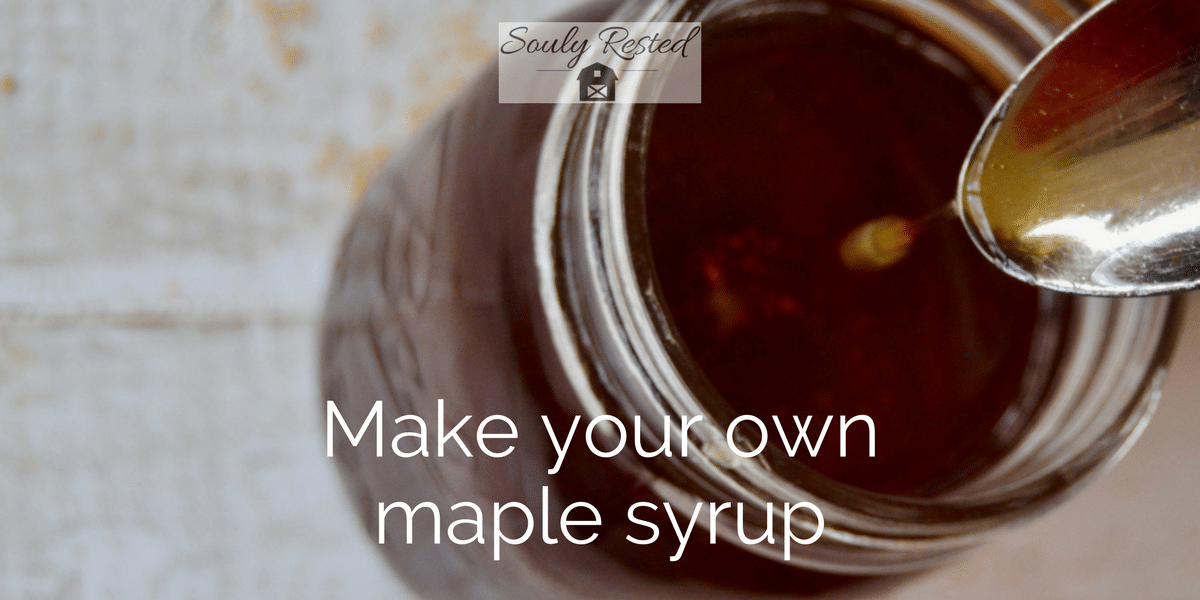
Before we dive into this delicious topic, I wanted to ask if you’d please consider helping me support sugarmaking education worldwide with every purchase of the SoulyRested Swag. You’ll find the latest designs right here (like the one I’m wearing here) .
Last winter, we longed to make our own maple syrup. So we gave it a try. And we pretty much failed. But boy did we learn a lot. And this year we’re gonna give it another try. Plus, no one ever said it was easy to make your own maple syrup. So I thought I’d share details with you, here on SoulyRested, as I learn more. And just imagine, if I succeed, I’ll have both Wild Blueberry Jam and Maple Syrup gracing my breakfast table this winter.
When fall settled in with full force last October, her cold winds relentlessly put an end to the beautiful color we were surrounded by for many glorious weeks. Nothing makes my heart sing with thankfulness to a masterful, artful creator more than a New England town cloaked in Autumn.

Before the leaves gave up their tenacious, colorful grip, we turned our focus toward thoughts of sugary, maple delicacies. We traversed our woods: my high school sweetheart with a can of fluorescent spray paint, I with my camera, and Bixby with unbridled excitement (always). The orange “x”s are beautiful marks of potential sweet syrup we hope to enjoy this winter.
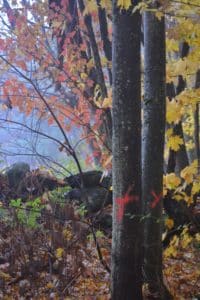
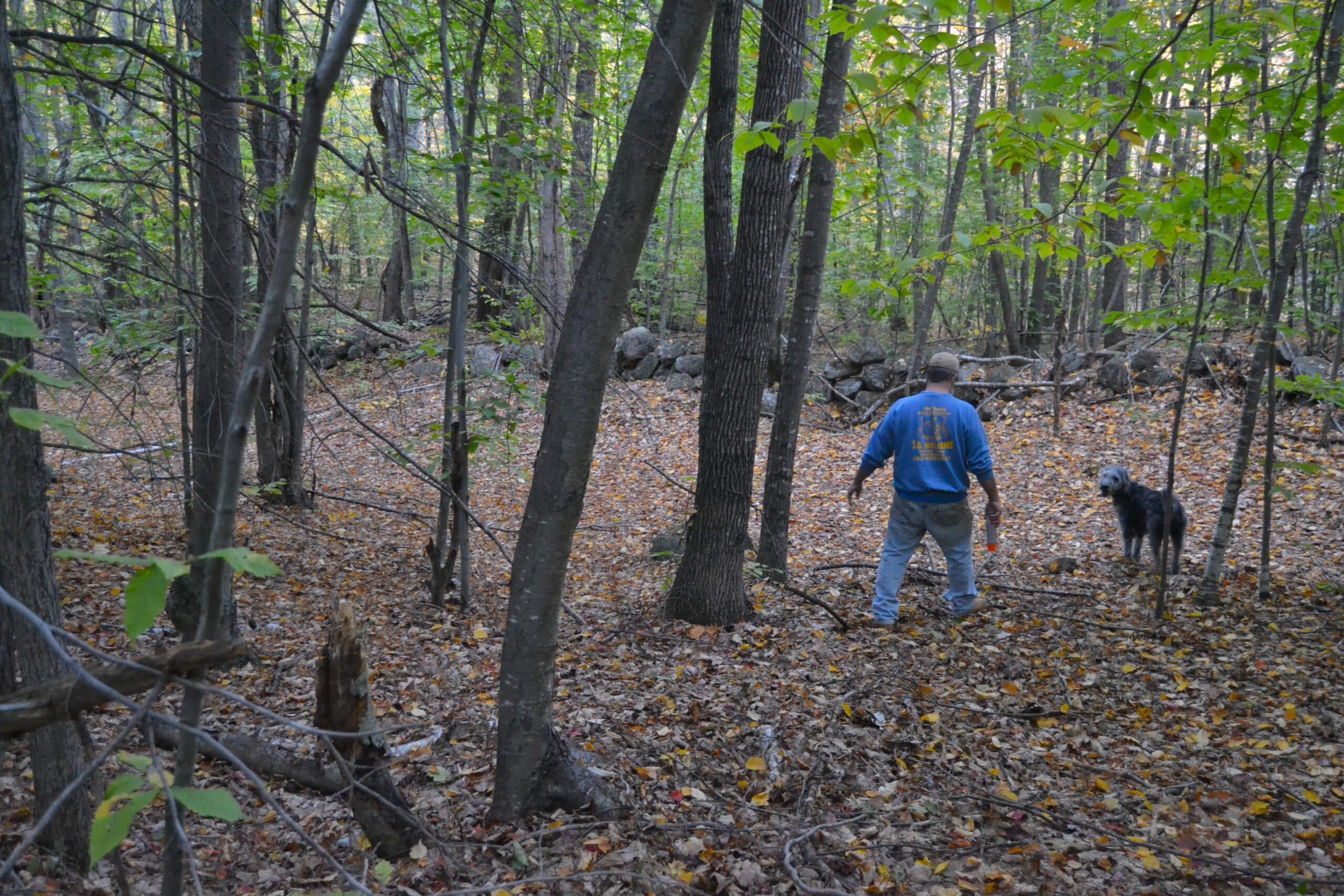
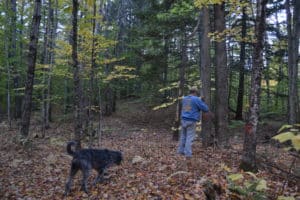
 We made many mistakes last winter in our first attempt to harvest maple syrup, but even in our mistakes, we wound up with some sweet results. In fact, if you make your own maple syrup, you too may find, as we did, that you enjoy the yummy product of your mistakes. Maple sugar turned out to be my favorite “failure” of all.
We made many mistakes last winter in our first attempt to harvest maple syrup, but even in our mistakes, we wound up with some sweet results. In fact, if you make your own maple syrup, you too may find, as we did, that you enjoy the yummy product of your mistakes. Maple sugar turned out to be my favorite “failure” of all.
Although we happened upon maple sugar accidentally, I’ll share how we made it in a future post. But if you’d like full directions for making your own homemade electrolyte-filled maple drink right now, just sign up above for my weekly newsletter. I will immediately send you access to my full resource library, including an amazing nutrient-rich drink that tastes amazing made with fresh maple sap but can also be made with water.
UPDATE: Go here to find out more about How to Make Maple Sugar. And make sure to click over for a free, printable comparison chart to see exactly how maple sugar stacks up against refined sugar.
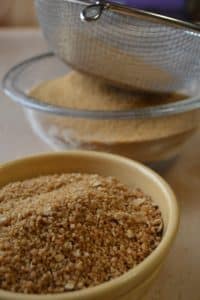
Here’s a little glimpse into some of the maple products we make here on our New England farm. You may be surprised by what my favorite product is!–>
So we’re ready to eagerly try again this winter. Heck, if we mess up again so deliciously, what do we have to loose? We had trouble finding good resources for our efforts last year, so I plan on documenting the process here, on SoulyRested, as we go along this winter. I figure maybe someone would like to learn from our failures. (So stay tuned, if you dare… you very well may wind up with some maple sugar cravings in the process of learning to make your own maple syrup. If you’re up to the temptation, follow along.)
We have other delicious thoughts on our homestead in the fall as well.
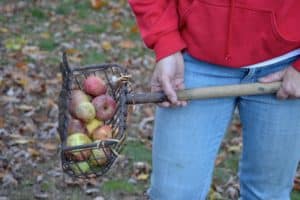
While the harvest was tiny this year, the apples have all been picked, and yummy apple cider is in the works. I’ll be sharing a recipe for that in a future post as well. (NOTE: I shared that deliciousness in this post–> Amazing Apple Cider.)
Then there’s our weekly hearth-baked night, which may be the best part of winter on our homestead.
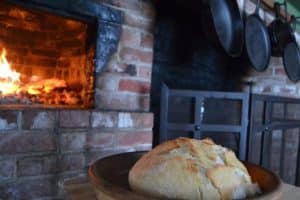
But it turns out I’ve discovered amazing recipes for pizza and bread on an oven stone that are so yummy we can’t tell the difference between them and our ones we bake in our brick oven. So I’ll be sharing those in future posts too.
So, as winter settles in, the firewood is stacked high. And soon enough we’ll be enveloped in the serenity of winter. But for today, we’ll just enjoy the sight of our orange “x”s and thoughts of sugary sweetness to come.
Fall is also the perfect time to build a DIY Reverse Osmosis System that can save you hundreds of dollars in fuel every year. Go here if you wanna know more about saving money making maple syrup.
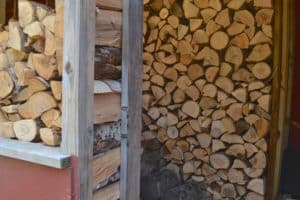
>>>>>>>>>><<<<<<<<<<
I’d love to share with you my recipe for a homemade electrolyte-filled drink made with maple sap (or plain water)! It’s just one of many awesome resources in my subscriber library. Share your email with me right here at this link or at the end of this post, and I’ll send you the link and your password immediately!
>>>>>>>>><<<<<<<<<<
If you live in an area where late winter temperatures stay below freezing all night, every night, and then rise to the 40s during the day, you’re in maple syrup country.
If you think you might like to try your hand at the whole sweet process and make your own maple syrup, you need to start by identifying and marking your maple trees. Then you’ll want to make sure you have all the supplies on hand that you’ll need when the sap starts to flow. Once you get the hang of it, you’ll be slathering your pancakes and maybe even making something deliciously fancy (like this amazing Homemade Maple BBQ Sauce that Jill shared on The Prairie Homestead) with the sweet results of your labor.
Take a Second to Save These Posts for Later
I know I come across helpful pointers online all the time that I plan on coming back to, only to realize later that I didn’t save the information, or I saved it but don’t remember where I saved it. So I wanted to save you the 20-minute heartache of floundering around for this muli-part DIY syrup series when you need it. You can PIN each post right here, then keep reading…
PIN this post (part 1), about identifying and marking your trees in the fall and gathering some of your preliminary supplies
PIN Part 2,(or read that one here) about when, where, and how to drill your taps. This post also covers how to know if you live where you can tap successfully and 7 questions you need to know the answers to before you tap your trees.
PIN Part 3,(or read it here) about a reverse osmosis filter–what it is, how to build one yourself, and how it can save you hundreds a year in your backyard syrup making process.
PIN Part 4, the step-by-step guide to boiling your sap.(Go here to read that one.) This posts walks you through every important detail you need to know when processing your syrup, from tree to pancake.
PIN Part 5, a guide to knowing the perfect time to stop tapping your maple trees. Don’t make the mistake that I did and assume you should keep on tapping until the sap stops flowing! (Go here to read that one.)
PIN Part 6, a guide to help you ID maple trees, in every season. (Or read it here.)
Or, if you’d like to know how to make a very different kind of syrup–read my post How to Make Lilac Syrup–or PIN it for later too.
Or, best of all, if you want to make sure you see everything I’ve ever written, or ever will write, on my blog about maple syrup, be sure to follow my Pinterest Board on that very topic.
Identifying your maple trees
The best ones for making syrup are the Sugar, Black, Red, and Silver maples. Once you’ve studied the bark patterns of those four types of maples, as well as their leaf shape and type of samaras (the winged seeds, or whirly-bird seeds, as my girls called them when they were my little girls), you’re ready to walk your property and find your maple trees. Take along a copy of my favorite tree ID book to help you.
Oh, if you missed it you may wanna hop over and view this fb live; I gave you the low-down on how to know if you have a sugar maple in your yard and why you really wanna know. And join me live on facebook at 9:50 a.m. EST every Tuesday morning.
♥ DISCLOSURE: This post contains affiliate links. Thank you! ♥
Marking your maple trees
You want the tree to be approximately 12″ or larger in diameter. When you’ve found the perfect trees, you can either make a map of the trees’ locations or mark the trees in some way. While we chose to paint an “x” on ours, you could tie plastic, fabric, or string ties around the trucks or large, low branches.
Of course you only need one such tree to try your hand at making syrup.
Gathering your maple syrup supplies
Once you’ve identified and marked your trees, you’ll want to start gathering your supplies, so you’re ready to tap the trees when the time is right. (For us, in New England last year, that was the end of February.)
These are the supplies you’ll need when the sap starts flowing:
- Cordless drill.
- Drill bits. Depending upon the type of spile used, either a 5/16 or 7/16 drill bit is used to drill the tap hole into your maple tree.
- Spiles (or taps). These are inserted into the drilled holes, to transfer sap into your storage containers.
- Hooks OR plastic tubing. Hooks are attached to the spiles and used to hang the bucket. We choose to sit our buckets on the ground and feed the tubing right to the buckets.
- Storage containers to hold your sap–we like using food-grade 5-gallon buckets with lids. We found these, very reasonably priced (with predrilled holes in the lids for the tubing), at our local Tractor Supply. I’ve read that deli or donut shops may be willing to give you food-grade buckets, for free, if they often have their ingredients delivered in them. It’s worth asking at least. I had originally thought we could save money on this piece of equipment and collect sap in modified milk jugs. But I can honestly say my husband was so right about the craziness of my idea. On ideal days, on our most productive trees, we gathered overflowing buckets full, in only half a day’s time. A milk jug would have never been big enough, and all that sap would have been wasted, spilling onto the ground every day.
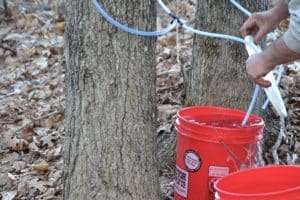
Enjoy maple yumminess while you wait for sugar season.
No need to wait until you’re ready to make your own syrup before you enjoy tons of all-natural, amazingly-delicious maple yumminess. I can’t recommend this family-run sugarhouse enough. My friend Tim makes delicious maple syrup, not to mention the cotton candy, maple cream, and single-serving packets of syrup-on-the-go (I love that!). Seriously, you want to check out all this maple yumminess.
Just collecting sap is cool too.
When sugar season arrives, if you want to do more than just collect maple sap, you’ll also need sap processing equipment. Here’s my complete list of what products I recommend for every backyard sugarmaker.
But don’t feel intimidated to jump in full-force if this will be your first winter as a backyard sugarmaker. You can choose to simply tap a few trees and collect the sap for drinking. You can use maple sap to make coffee and tea, even brew beer I’m told. In fact, you can use maple sap water in just about any recipe that calls for water. It adds a very subtly sweet maple flavor. And you can chill it and drink it in place of water. In fact, in our area, companies do just that, selling chilled, bottled, maple-flavored water.
So this year if you wanna tap one maple tree, or try your hand at a forest full, I’m betting you’ll enjoy sweet rewards. Follow along here on SoulyRested for more details about when and how to tap your trees, collect your sap, and process your syrup and sugar. And be sure to read Part Two in my Make Your Own Maple Syrup Series.
If you liked this article, you’ll want to check these out too:
Check out this comparison chart, comparing refined sugar to maple.
Find out how a backyard sugarmaker can save hundreds of dollars a year.
How precious is your steadfast love, O God!
The children of mankind take refuge in the shadow of your wings.
They feast on the abundance of your house,
and you give them drink from the river of your delights. Psalm 36: 7-8
If you enjoyed this post, you’ll love my crash course, Making Maple Sugar, and you’ll want a copy of Sweet Maple, Backyard Sugarmaking From Tap to Table.
V V V V V V V V V V V V
Please follow along!
Please take a second to follow along here on SoulyRested and enjoy immediate access to my subscriber library of resources, which includes many useful printables, including helpful ones related to backyard maple syrup. And, destined to be the most popular item in my Resource Library–A SWEET TASTE–this giant, full-color, 5-chapter, 33-page eBook is my gift to you… a tiny introduction to Sweet Maple.
Your FREE copy of A Sweet Taste includes:
— 8 Questions everyone should ask before they tap trees.
— Amazing recipes using all-natural maple syrup.
— Numerous reasons that maple should be your favorite sweetener.
— A long list of what makes sugar maples so special.
Glance at my Resource Page if you’d like to get a glimpse of all the supplies I use and recommend for everything from gardening, to homeschooling, to chicken care, to nature journaling, to maple syrup making.
I’d love to connect!
To find me in some other neck of the woods, just click any (or every!) icon below:
Pin this for later!
Just click the image below.–>
Don’t forget to subscribe for access to my Resource Library. There you’ll find my FREE EBOOK–A Sweet Taste–as well as amazing recipes for things like whoopie pie cookies, maple sap switchel, and Grandmom’s perfect pie crust.
Just type your email address in the box below.
v v v v v v v v v v v

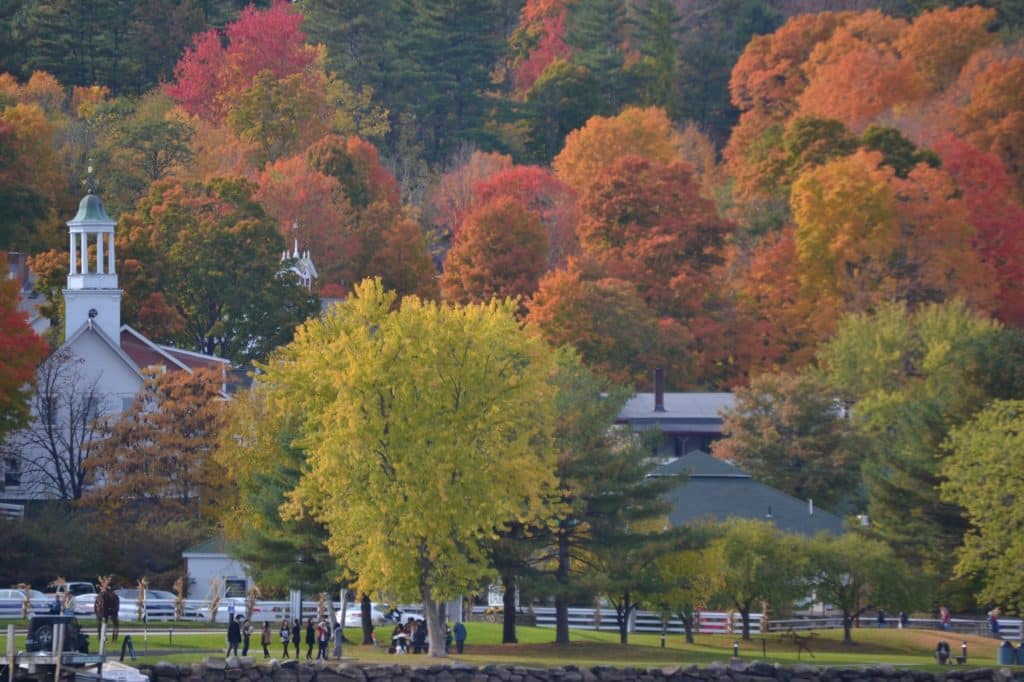
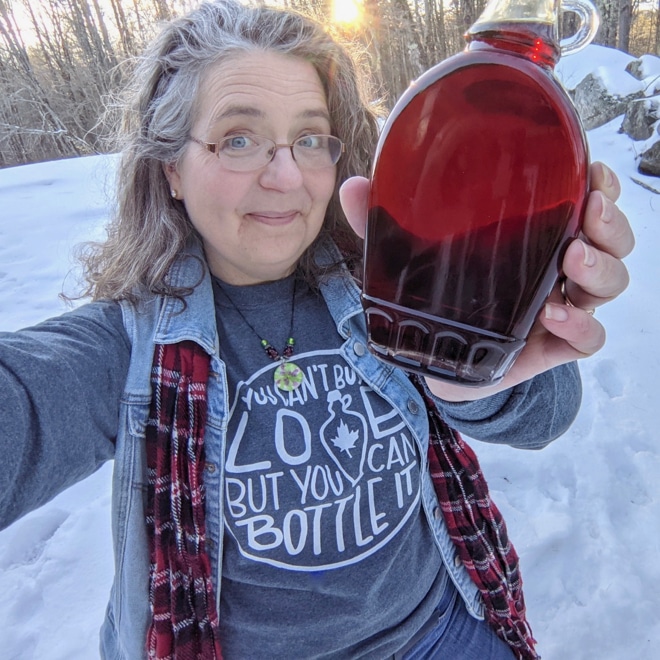
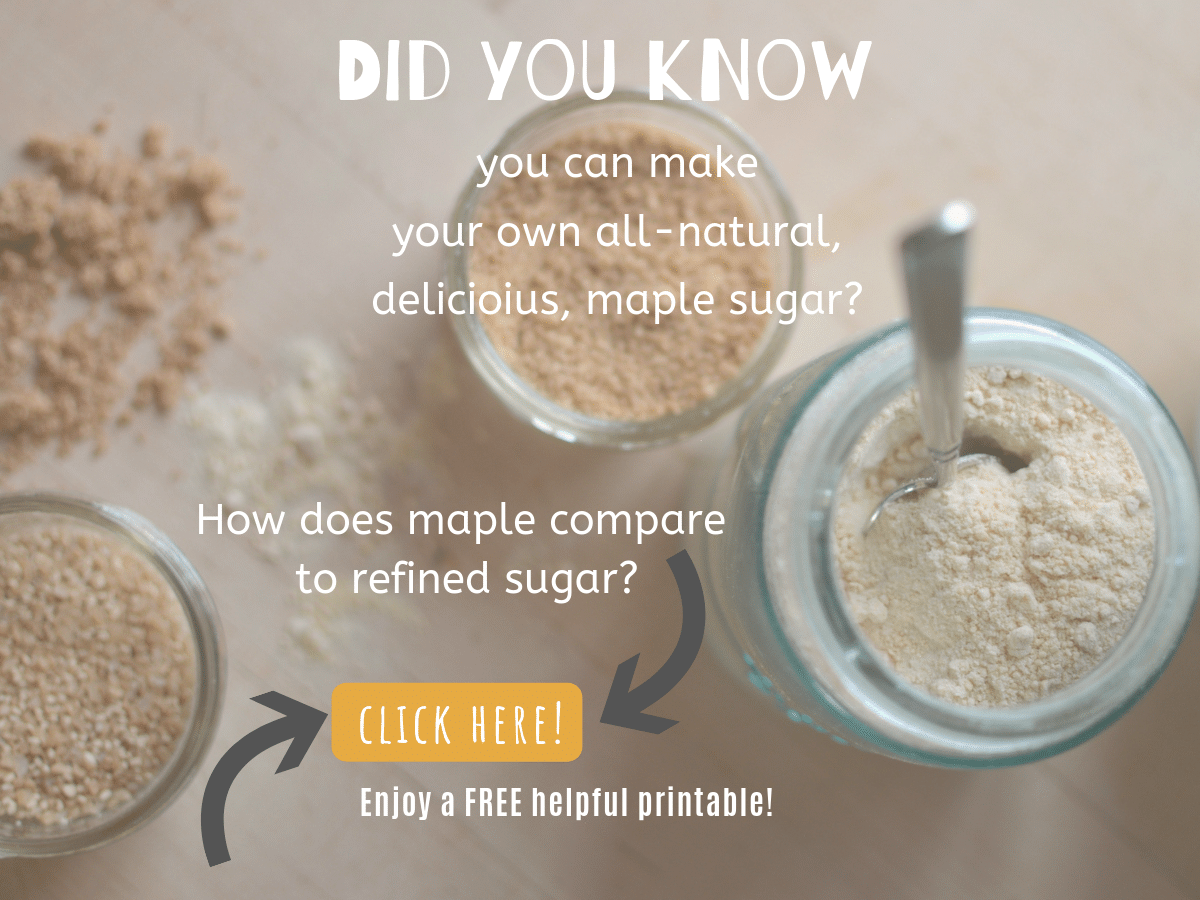

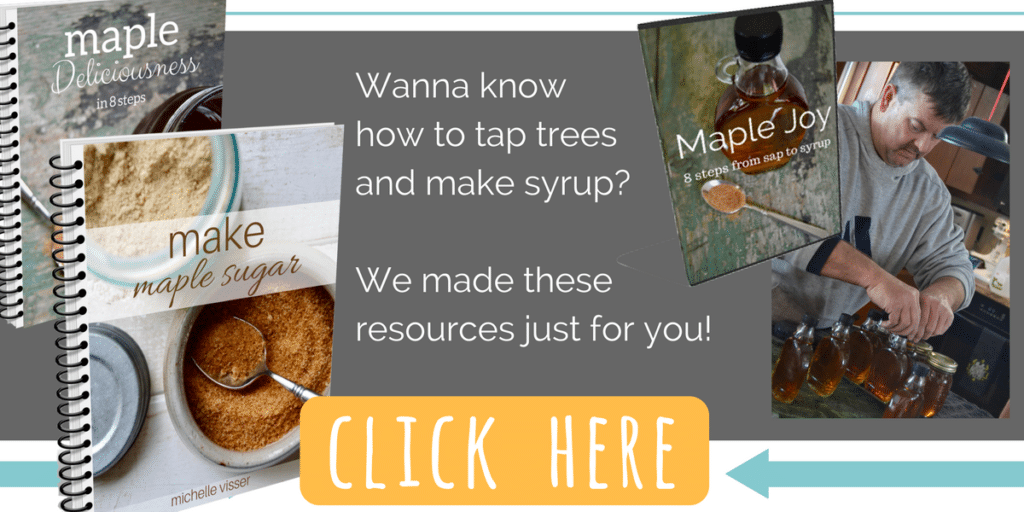
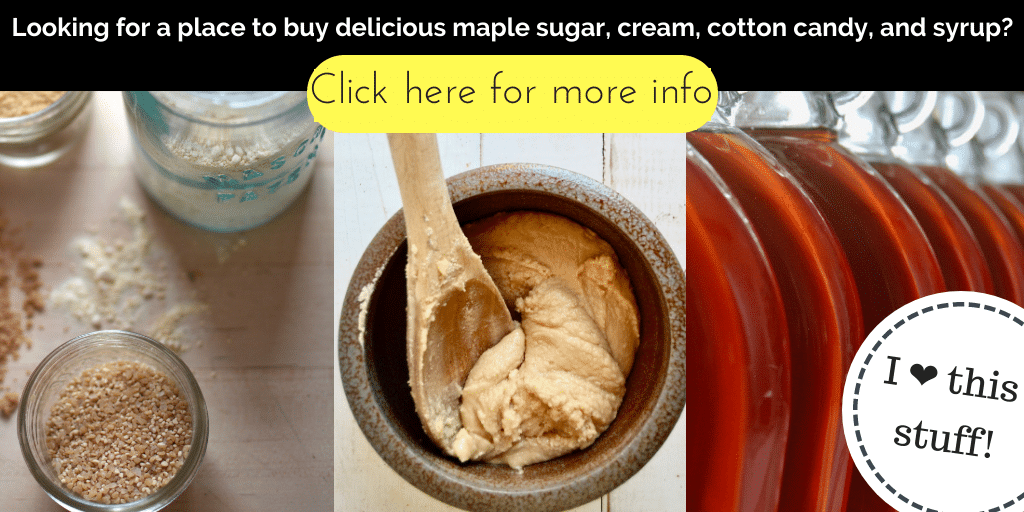

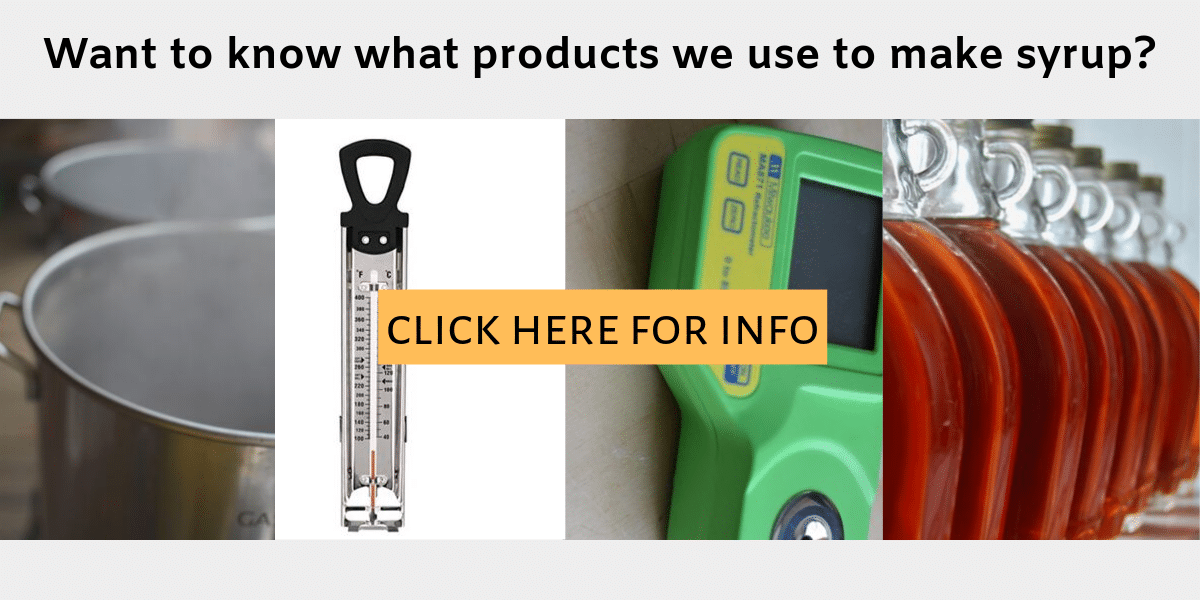
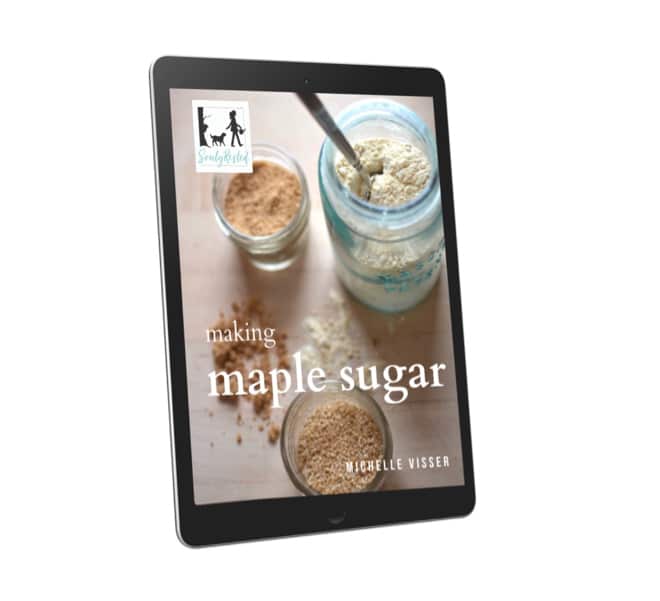
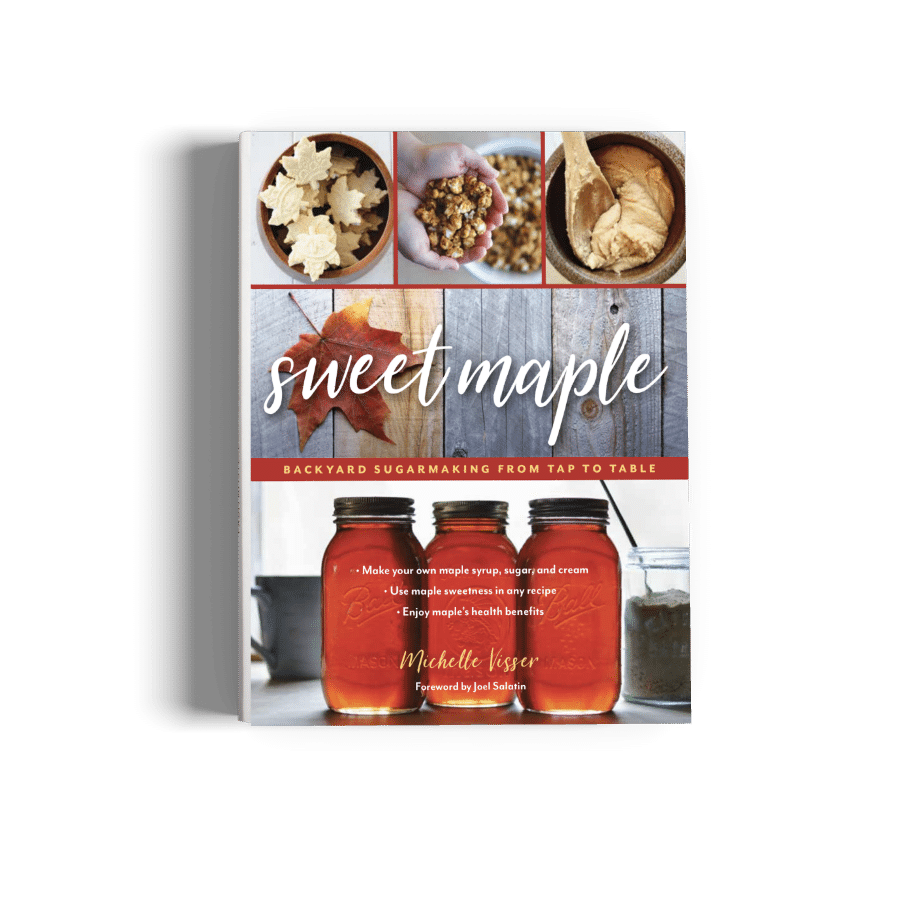
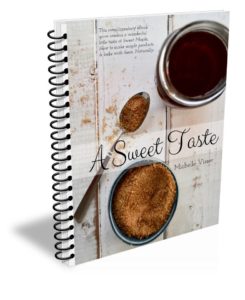




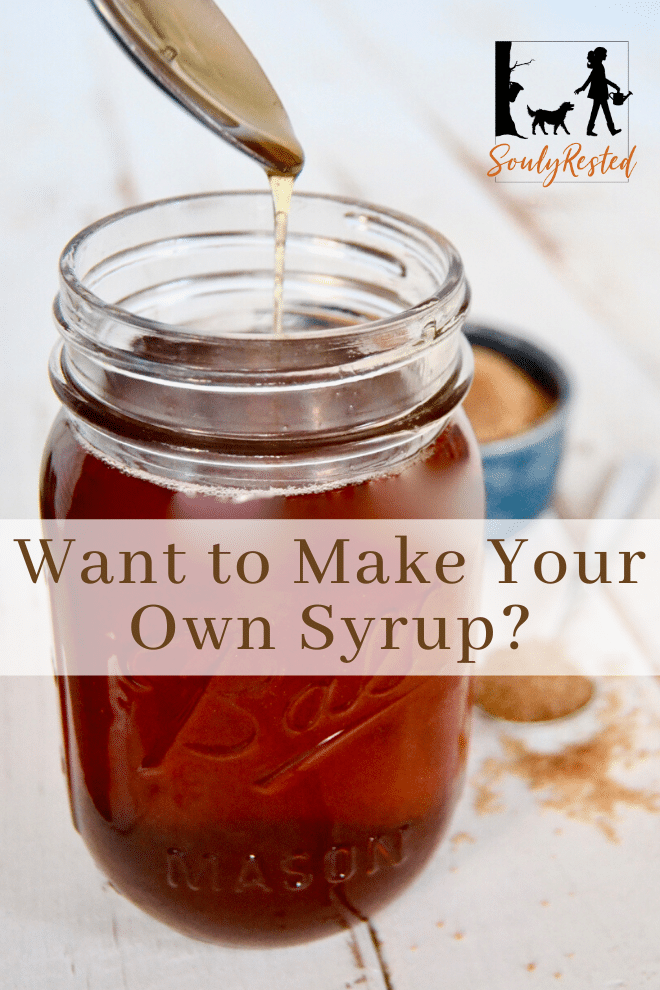
How exciting! I look forward to following along. Did you know that other types of trees can be tapped as well? I didn’t until a few years ago, and don’t remember the list, but black walnut are among them. We have a lot of those, so a few years I tired it out. I think I got started a little on the late side and didn’t collect all that much sap, but it came out good! I may be inspired to try again this year. It takes a lot more sap of other types of trees, because of a lower sugar content, I think, so that’s why maple is favored. I love the picture of your apples, too! I have young apple trees, so I may be able to try making cider someday.
Yes, I had heard that other trees could be tapped–thank you for pointing that out, Michelle! And our apple trees are on the other spectrum from yours… Ours are very old. In the three apple seasons since we’ve lived here, production has been dramatically different each year… I’m glad you’ll be following along!
First-time-reader, through Jill Winger, the Prairie Homesteader! Your way of life seems so homey and I love the scriptures you include!
So glad you hopped over here Elizabeth! (I adore Jill, and I was tickled yesterday when she told me she’d be sharing my maple syrup post.) I hope you take a second to jump on my weekly newsletter list; I’d love to send you my update of the mistakes I’m learning from every week. 🙂 My teens tell me I romanticize our life, and maybe I do… but we are indeed very blessed.
Try this. We drink it all through the spring, and everyone loves it.
1 gallon sap, 6-8 cucumber slices, 4 strawberries – cut in halves or quarters
This sounds wonderful! I will absolutely be trying this this March. Thanks for sharing; now I’m more eager than ever for the sap to start flowing!
I can’t get enough of your photos, Michelle! Where you live looks positively dreamy 🙂 How do you feel about shipping your delicious and fresh maple syrup? 😉
We’ll have to talk, Sammi! Last year was our first go-round at the whole maple syrup thing, so we barely had enough for ourselves, but we’ve been reading, talking to experts, and learning a lot. So I’m truly hoping we have a few jars to sell this year. And I’m sure we could ship one or two. 🙂
I noticed some sap buckets hanging in the backyard of a home that I drive by on my way home which has started me thinking: we have 4 acres; about 2 of it is woods. We have maples and black walnut primarily. Do any maples qualify for tapping, or only certain ones? I grew up in the Adirondacks and our neighbors had a sugar bush so I am only familiar with syrup making on that large scale, not a few buckets in the back yard. They kept a wood fire continually burning under a gigantic open vat of sap day and night. Some of my fondest memories are of eating syrup drizzled over snow in a cup.
If it is a maple, Betsy, it is a wonderful candidate for tapping… truly ANY maple, along with your Black Walnuts! in fact, there is a list of 23 trees that make wonderful syrup in my subscriber library, which you’re welcome to download. Maybe you have even more tappable trees! I highly recommend getting a few taps and buckets and gathering some of your sap right away. The sap starts to turn bitter tasting as soon as the tree buds start to swell.